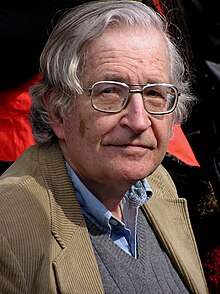نٲؤم چومسکؠ
Appearance
یہ چھُ اَکھ یتیٖم صَفہٕ تِکیٛازٕ یور چھِ نہٕ باقٕے صَفہٕ یِوان۔ مہربٲنی کٔرِتھ کٔرِو باقٕیَن مَضموٗنَن یَتھ مَضموٗنَس سٕتؠ جوڈ۔ |


نٲؤم چومسکؠ چھُہ اَکھ امریکی ماہر لسانیات، فِلاسفَر،[1][2] علمی ساینٔسی، ترکشاستری،[3][4][5] سیاسی مبصر، سَمٲجی انصاف سرگرم کار کُن، تہٕ انارکو سیندکلسٹ ایڈووکیٹ.
حوالہٕ جات
[اؠڈِٹ]- ↑ "Noam Chomsky" آرکایو کۆرمُت 2015-02-13 بذریعہ ویے بیک مَشیٖن, by Zoltán Gendler Szabó, in Dictionary of Modern American Philosophers, 1860–1960, ed۔ Ernest Lepore (2004). "Chomsky's intellectual life had been divided between his work in linguistics and his political activism, philosophy coming as a distant third۔ Nonetheless, his influence among analytic philosophers has been enormous because of three factors۔ First, Chomsky contributed substantially to a major methodological shift in the human sciences, turning away from the prevailing empiricism of the middle of the twentieth century: behaviorism in psychology, structuralism in linguistics and positivism in philosophy۔ Second, his groundbreaking books on syntax (Chomsky (1957, 1965)) laid a conceptual foundation for a new, cognitivist approach to linguistics and provided philosophers with a new framework for thinking about human language and the mind۔ And finally, he has persistently defended his views against all takers, engaging in important debates with many of the major figures in analytic philosophy..."
- ↑ The Cambridge Dictionary of Philosophy (1999), "Chomsky, Noam," Cambridge University Press, pg۔ 138. "Chomsky, Noam (born 1928), preeminent American linguist, philosopher, and political activist... Many of Chomsky's most significant contributions to philosophy, such as his influential rejection of behaviorism... stem from his elaborations and defenses of the above consequences..."
- ↑ Edwin D. Reilly (2003). Milestones in Computer Science and Information Technology. Greenwood Publishing Group. pp. 43–44. ISBN 978-1-57356-521-9.
In 1956, the logician Noam Chomsky showed that there are only four basically different forms Church-Turing thesis of grammar, which, in decreasing order of sophistication, he called grammars of Type 0, 1, 2, and 3.
. Viewed July 15, 2012. - ↑ H. L. Somers (2003). Sergei Nirenburg, H. L. Somers, Yorick Wilks (ed.). Readings in Machine Translation. MIT Press. ص. 68. ISBN 978-0-262-14074-4.
I think that this should be of sufficient interest to warrant some more detailed exhibition, especially since this insight is due to an important new, not to say revolutionary, view of the structure of language, recently outlined by the American linguist and logician Noam Chomsky [2], and could perhaps, in its turn and in due time, be turned into a new method of machine translation, which would be more complex than the known ones but also more effective.
CS1 maint: multiple names: editors list (link). Viewed July 15, 2012. - ↑ Carlos Peregrín Otero, ed. (1994). Noam Chomsky: Critical Assessments, Volume 1; Volume 3. Taylor & Francis. pp. 14–15. ISBN 978-0-415-10693-1.
Chomsky is a professional linguist, a competent mathematical logician, and a trained methodologist with a keen critical sense and an uncanny ability to follow the most abstruse mathematical argument or, if necessary, to produce one himself.
